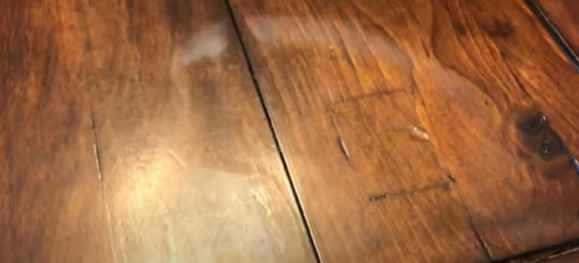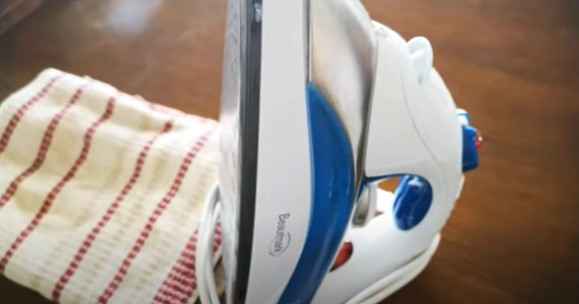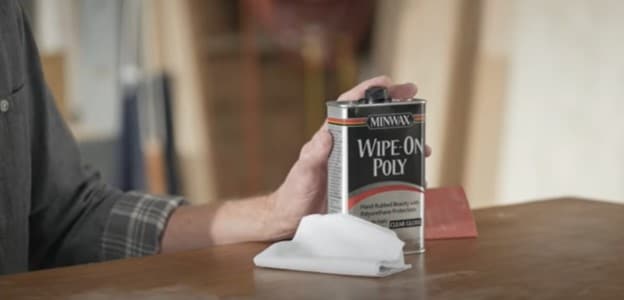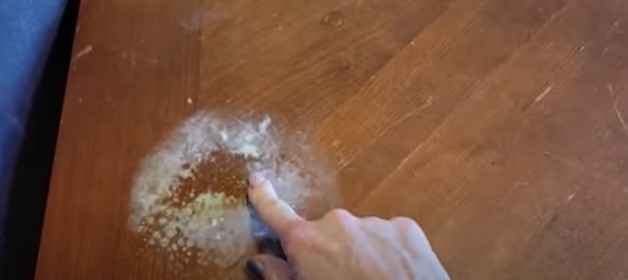To remove marks from a dining table, identify the stain type and use appropriate cleaning solutions. Gentle rubbing with a soft cloth often helps to lift blemishes.
Keeping your dining table spotless adds to the beauty and longevity of one of the most essential pieces of furniture in your home. A dining table is a hub for family gatherings, celebrations, and everyday meals, making it susceptible to a variety of marks and stains from spills, heat, and general wear and tear.
Maintaining its pristine condition requires prompt and appropriate care. Understanding the material of your table—be it wood, glass, or marble—is crucial to selecting the right cleaning method. Let’s explore the topic “How to Get Marks Off Dining Table?“
This piece of advice will guide homeowners and cleanliness enthusiasts through the simple steps needed to eradicate unwanted marks from their dining surfaces, ensuring your table remains an inviting centerpiece for years to come.
Introduction To Dining Table Care
Your dining table is more than just furniture; it’s where memories are made. Taking care of your table ensures its longevity and beauty. With proper maintenance, it can remain a centerpiece to be proud of for years to come.
Importance Of Dining Table Maintenance
Maintaining your dining table isn’t just about keeping it clean. Regular care prevents damage and preserves its value. A well-maintained table can handle daily use and look stunning.
- Enhances appearance: A clean table makes a great impression.
- Increases durability: Protective measures guard against wear and tear.
- Preserves value: Properly cared-for tables can retain or increase in value.
Types Of Marks Commonly Found On Dining Tables
Different marks can spoil the look of your table. Identifying them is the first step to proper care.
| Mark Type | Description | Cleaning Method |
|---|---|---|
| Water Rings | Marks left by wet glasses or bottles. | Gently wiped with a soft cloth. |
| Heat Marks | White spots from hot dishes. | Apply mild heat and wipe off. |
| Scratches | Small cuts from sharp objects. | Use a wood marker or walnut for disguise. |
| Stains | Discolorations from food or ink. | Clean with a suitable stain remover. |
Preventative Measures
Your dining table is not just a place for meals. It’s a centerpiece that needs care. Like a shield protects a knight, simple steps can guard your table against marks and stains. Let’s dive into how you can keep your dining table looking its best with some preventative measures.
Using Tablecloths And Placemats
Tablecloths and placemats are your first defense line. They aren’t just decorative; they are functional. Think of them as a barrier. They catch crumbs, spills, and heat marks, keeping your table safe.
- Choose the right material: Easy-to-clean fabrics or wipeable plastics are best.
- Don’t forget style: Pick colors and patterns that match your room.
- Have a set for different occasions: Everyday use and special dinners.
Remember, tablecloths and placemats also need regular cleaning. This ensures they remain effective guards for your table.
Regular Cleaning Routines To Avoid Staining
Consistency in cleaning can prevent long-term damage. Tend to spills and stains right away. A gentle reminder – always be gentle.
| Frequency | Cleaning Task |
|---|---|
| After Each Use | Wipe with a damp cloth. |
| Weekly | Use a mild cleaner. |
| Monthly | Polish wood tables. |
Stick to these routines. Consistent care equals a lasting, mark-free dining table. It’s the everyday steps that keep the wear and tear away. Just a bit of attention, dedication, and the right tools, and your dining table can stay spotless for years to come.
Natural Cleaning Solutions
Kitchens buzz with activity but accidents happen, especially on dining tables. Natural cleaning solutions are a gentle way to clean. They do not harm surfaces. Plus, they keep your family safe from harsh chemicals. Let’s discover some home remedies that will help you get those unsightly marks off your dining table.
Vinegar And Olive Oil For Wood Tables
Wood tables need special care. A mixture of vinegar and olive oil works wonders. It cleans and conditions the surface. This combination creates a natural polish. It brings back the shine of your wood table. Follow these simple steps:
- Mix equal parts of vinegar and olive oil.
- Apply the mixture with a soft cloth. Rub it into the wood.
- Rub gently until the marks disappear.
- Wipe off any excess with a clean cloth.
Baking Soda For Removing Stubborn Marks
Baking soda tackles tough marks. Its gentle abrasive quality makes it perfect for persistent stains. Use it on your dining table by following these steps:
- Make a paste with baking soda and water.
- Spread the paste on the stain.
- Let it sit for a few minutes.
- Gently scrub with a soft sponge.
- Rinse with a damp cloth and dry the area thoroughly.
Dealing With Scratches
Your beloved dining table now has scratches. Countless meals and gatherings have left their mark. But fear not, you can restore your table’s shine. Let’s tackle those blemishes head-on. We will explore how to assess scratch depth and DIY fixes for minor imperfections. Each step ensures your dining table looks as good as new.
Identifying The Depth Of Scratches
Assessment is key. Run a fingernail over the scratch. If it snags, you’ve got a deep scratch. Shallow ones feel smooth. This distinction guides our approach. Below is a quick reference chart:
| Scratch Depth | Characteristic | Treatment Approach |
|---|---|---|
| Light | Hardly catches the nail | DIY solutions work well |
| Medium | Catches the nail slightly | May need a filler |
| Deep | Nail notably snags | Professional repair suggested |
Diy Solutions For Minor Scratches
Minor scratches call for simple fixes. Start with home remedies. Use everyday items like olive oil and vinegar. Mix them in equal parts and apply with a soft cloth. For scratches that need a bit more care, consider these steps:
- Walnut Rub: Rub a walnut on the scratch. Natural oils mask light blemishes.
- Iodine or Markers: For darker tables, iodine or a similarly colored marker can disguise the scratch.
- Sand and Refinish: Lightly sand the area and seal with finishing oil.
Don’t forget to test products in a hidden spot first. This ensures you don’t create a bigger problem. Seal your work with beeswax or polish to protect the table’s surface. Your goal: make scratches vanish and prevent future damage.
Treating Water Rings And Heat Marks
Water rings and heat marks on a dining table can be unsightly, marring the beauty of the wood. But fret not! With the right approach, those pesky blemishes can become a thing of the past. We’ll explore safe and effective methods to restore your table’s elegance without causing any harm to the wood’s finish.
Methods To Remove Water Rings

Water rings can look alarming, but they are often only in the wax or finish on top of the wood. By addressing these marks promptly, full restoration is possible. Here are reliable techniques to wipe those water rings away:
- Non-Gel Toothpaste: Apply a small amount and rub gently with a soft cloth.
- Baking Soda: Make a paste with water. Apply and rub in a circular motion.
- Mayonnaise: Leave a dollop on the ring for an hour, then wipe off and buff.
- Commercial Cleaners: Choose products designed for water ring removal.
Tactics To Eliminate Heat Marks Without Damaging The Wood

Heat marks can be stubborn, but careful tactics can banish them effectively. Always test a small, inconspicuous area first. Delicate wood finishes need considerate care.
- Ironing: Place a cotton cloth on the mark. Use a warm, not hot, iron on a dry setting.
- Blow Dryer: Use a blow dryer on a low setting, moving it around not to overheat one spot.
- Oil and Salt: Mix olive oil and salt to create a paste. Apply, let sit, then gently remove and polish.
Repeat applications may be necessary for tougher marks. Patience and gentle methods protect your wood’s integrity while restoring its natural beauty.
Removing Sticky Residues
At some point, sticky spills happen on dining tables. Syrup drips, jelly blobs, or gum accidents can turn your beautiful dining surface into a tacky mess. Fear not, as there are safe and easy methods to tackle these issues without harming your table’s finish.
Safe Ways To Deal With Gum Or Adhesives
To remove gum or adhesives, freeze the area first. Here’s a simple guide:
- Chill the gum with an ice cube in a plastic bag.
- Wait a few minutes until it hardens.
- Gently scrape away with a plastic putty knife.
With adhesives, oil-based products like eucalyptus oil or cooking oil can help. Apply a small amount onto a cloth and rub the residue gently.
Tips For Removing Sticky Food Spills
Sticky food spills need a gentle touch. Follow these steps:
- Soak a cloth in warm, soapy water.
- Wring it out so it’s damp, not dripping.
- Place over the spill for a minute to loosen.
- Wipe away gently.
For sticky sweets or syrups, a solution of vinegar and water works well. Mix 1 part vinegar with 2 parts water. Soak a cloth in the solution, wring it out, and then place it over the affected area.
The acidic nature of vinegar dissolves stickiness without damaging wood finishes.
Stain Removal Techniques For Various Finishes
Have you ever found yourself staring at a stubborn mark on your dining table? You’re not alone. Different table finishes require unique care and specific cleaning methods. Whether it’s a family heirloom or a recent purchase, knowing how to tackle stains can keep your table looking pristine.
Let’s explore the removal techniques that cater to the finishes you may have in your home.
Different Approaches For Varnished, Painted, Or Untreated Surfaces
Varnished surfaces demand a gentle touch. Use a mixture of mild soap and water to wipe the area softly. For more stubborn marks, create a paste of baking soda and water, apply gently, then wipe away cleanly.
Painted tables can be sensitive to harsh chemicals. Start with soap water. If needed, escalate to a vinegar water solution, but always perform a patch test first.
Untreated wood absorbs stains deeper, making them trickier. Use a mix of salt and lemon juice to draw out the stain. Afterward, oil the wood to restore its natural beauty.
Appropriate Cleaning Agents For Each Finish
- Varnished surfaces: Stick to pH-neutral soaps.
- Painted surfaces: Mild detergents are safest.
- Untreated wood: Natural solutions like lemon work best.
| Finish Type | Cleaning Agent | Application |
|---|---|---|
| Varnished | Mild Soap | Soft Cloth |
| Painted | Detergent | Gentle Rubbing |
| Untreated | Lemon and Salt | Rinse off |
Repairing Deep Scratches And Gouges
Deep scratches and gouges can make a dining table look worn and old. Yet, you can bring it back to life with the right techniques. Remedies depend on the damage severity. Minor marks often need a simple touch-up, while bigger ones need a bit more work.
Filling and refinishing techniques work best for severe damage. Learn how to assess the damage and pick the right approach here.
When To Call A Professional
Sometimes, the damage to your table might be too tricky for do-it-yourself fixes. Here are signs that you need a pro:
- Deep damage spans large table areas.
- Cracks show signs of wood splitting.
- The table has antique value that could decrease with DIY methods.
Woodworking experts have the right tools and skills. They ensure your table keeps its value and beauty.
Filling And Refinishing Techniques For Severe Damage
Deeper scratches need special care. Follow these steps to repair severe table damage:
- Clean the area using a soft cloth and wood cleaner.
- Apply wood filler that matches your table’s color.
- Let the filler dry according to the product instructions.
- Once dry, gently sand down the filler until it’s flush with the table surface.
- Finish with a layer of wood stain that matches your table, if needed.
- Seal the area with a protective clear coat for a lasting finish.
Always test products on a small area first. This avoids further damage to the table.
Tip: Choose a wood filler that’s slightly darker than your table. Stains often look lighter on repairs.
Polishing And Protecting After Cleaning

Cleaning your dining table leaves it sparkling, but polishing and protecting are key to maintaining its shine. After banishing stains and marks, securing the clean surface with the right polish and protectants is essential.
These steps not only enhance the wood’s natural beauty but also shield it from future wear. Let’s ensure your table stays mark-free for years to come.
Choosing The Correct Polish For Your Table Type

Choosing the right polish for your table can make all the difference. Different table materials require specific care. Use this guide to select the best polish:
| Table Material | Recommended Polish |
|---|---|
| Wood | Bee’s wax or oil-based polish |
| Glass | Foam glass cleaner |
| Marble | Stone-safe polish |
| Metal | Metal cleaner or polish |
Always test a small area first. Apply gently with a soft cloth.
Applying Protectants To Prevent Future Marks
After polishing, applying a protectant is crucial for long-term care. Here’s how to keep your table flawless:
- Use coasters and placemats to safeguard against hot and cold items.
- Invest in a tablecloth for added protection during mealtimes.
- Apply a sealant if appropriate for your table type. It adds an extra layer of security.
Regular maintenance combined with these protective tips ensures a durable and striking dining table surface.
Professional Services For Dining Table Restoration
Your dining table is a centerpiece in your home, a gathering spot for family and friends. Marks and scratches can mar its beauty. Sometimes, DIY solutions fall short. Professional dining table restoration can restore your table’s original glory, enhance the life of your furniture, and maintain your home’s aesthetic appeal.
Deep scratches, extensive watermarks, or structural damage – these are signs you might need a professional restaurateur for your dining table. If the table holds sentimental value or is an antique, professional refinishing is essential to preserve its integrity.
Finding a skilled professional requires due diligence. Seek providers with positive reviews and a robust portfolio of previous work.
- Check credentials and certifications.
- Ask for before-and-after photos of previous restorations.
- Inquire about the materials and techniques used.
- Get a detailed quote.
Ensure transparency in communication. A trustworthy service provider will not hesitate to answer your questions.
Maintaining Your Dining Table’s Beauty
Maintaining your dining table’s beauty is much like caring for a treasured artwork. With time, marks and spills can occur, but they don’t have to become permanent features. Wrapping up our guide, let’s ensure your table continues to spark conversations and compliments for years to come.
Summarizing Best Practices For Dining Table Care
- Use coasters to avoid ring stains.
- Place mats can protect from scratches.
- Wipe spills quickly with a soft cloth.
- Apply gentle cleaners suited for your table’s material.
- Avoid harsh chemicals which can damage the finish.
Encouraging Regular Maintenance And Prompt Mark Removal
- Clean regularly to prevent dust build-up.
- Inspect your table often for any new marks.
- Act quickly when accidents happen.
- Seek professional help for tough stains.
- Nourish wood tables with polish every few months.
Frequently Asked Questions For How To Get Marks Off Dining Table
How To Remove Stains From A Wood Dining Table?
To remove stains from a wood dining table, gently rub the area with a mixture of baking soda and water. Apply with a soft cloth, follow the grain, and finish by wiping clean with a damp cloth.
What’s The Best Way To Clean A Varnished Table?
For a varnished table, use a solution of mild dish soap and warm water. Dampen a soft cloth in the mixture, wring it out well, and gently wipe the surface. Dry immediately with another clean cloth.
Can Vinegar Safely Clean Dining Tables?
Yes, diluted white vinegar is safe and effective for cleaning dining tables. Mix equal parts of vinegar and water, apply with a soft cloth, and then buff dry. Avoid over-saturation to protect the wood finish.
How To Fix Heat Marks On Wood Tables?
To fix heat marks on wood tables, lay a cotton cloth over the mark and carefully iron on a low setting. Keep the iron moving to prevent further damage. Alternatively, use a specialized wood polish or cleaner.
How Do You Clean Table Marks?
To remove table marks, start by gently wiping the affected area with a soft, damp cloth to lift any surface dirt. If the marks persist, mix a solution of mild dish soap and water, then carefully dab the stains with the solution using a clean cloth, followed by a thorough dry wipe to maintain the table’s finish.
Conclusion
Maintaining a pristine dining table is attainable with these easy steps. Embrace these methods to tackle marks effectively, preserving your table’s charm. For enduring results, consistent care is key. Armed with this guide, say goodbye to blemishes and hello to lasting beauty in your dining space.
Keep your table guest-ready always!

